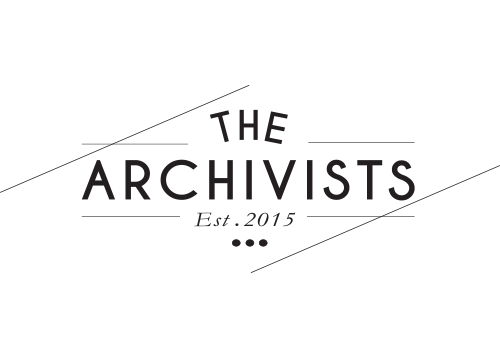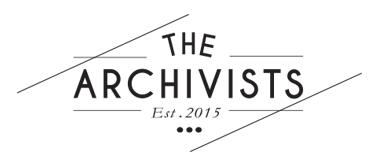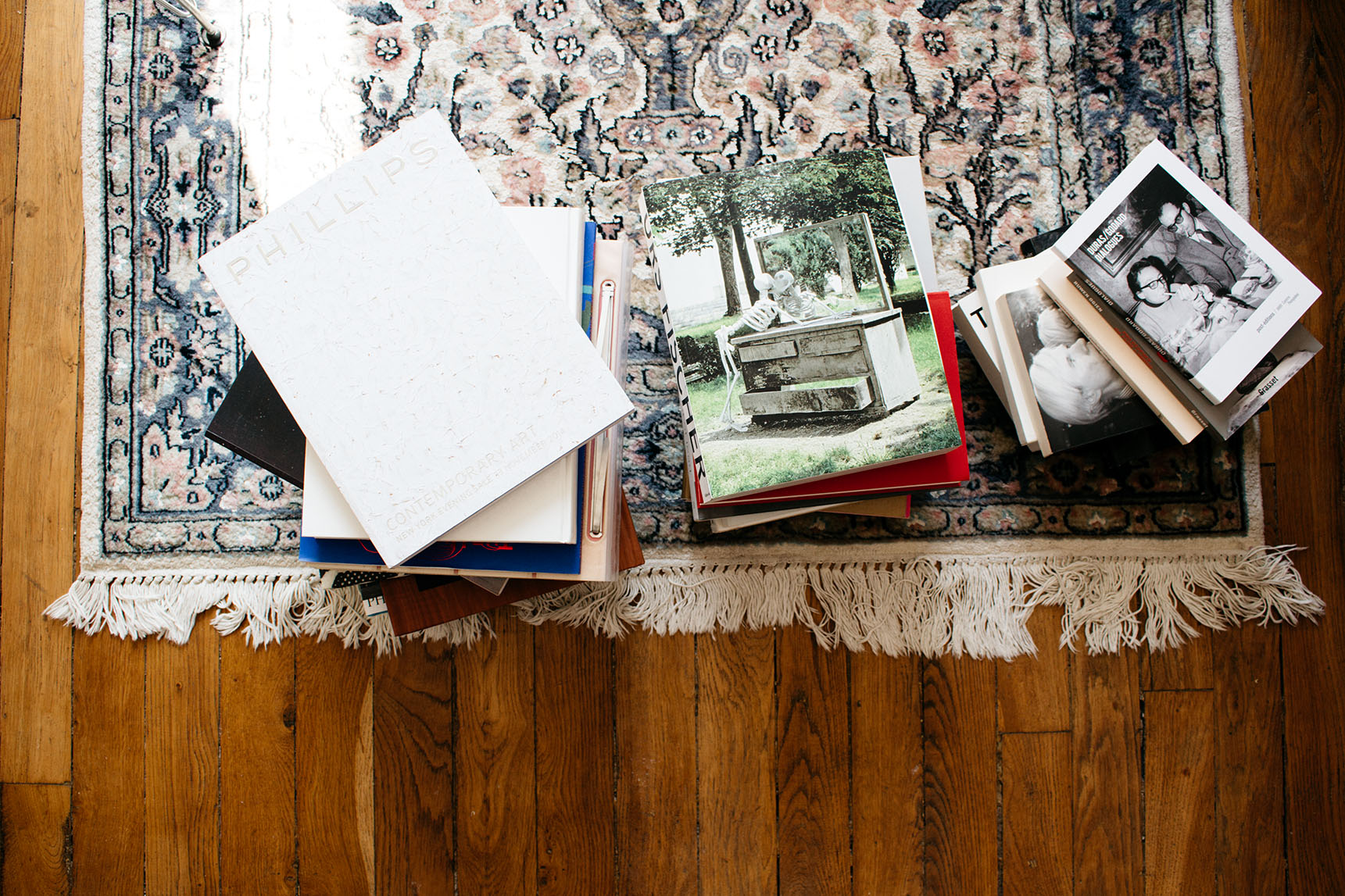
17 Mai TIMOTHÉE




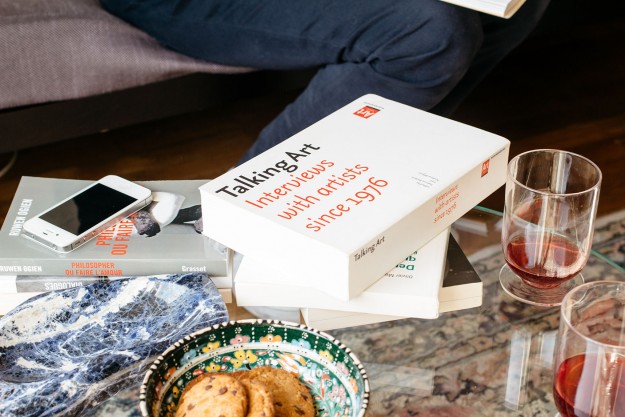
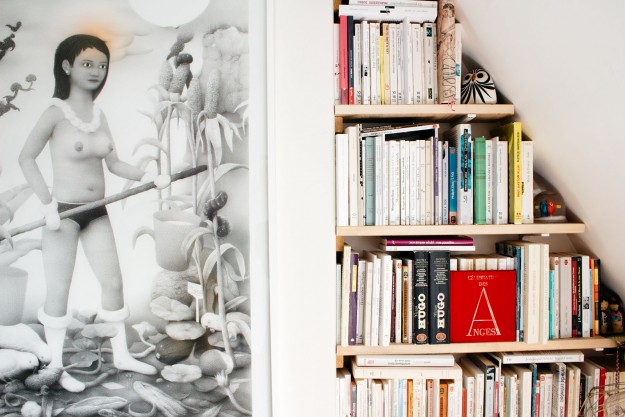
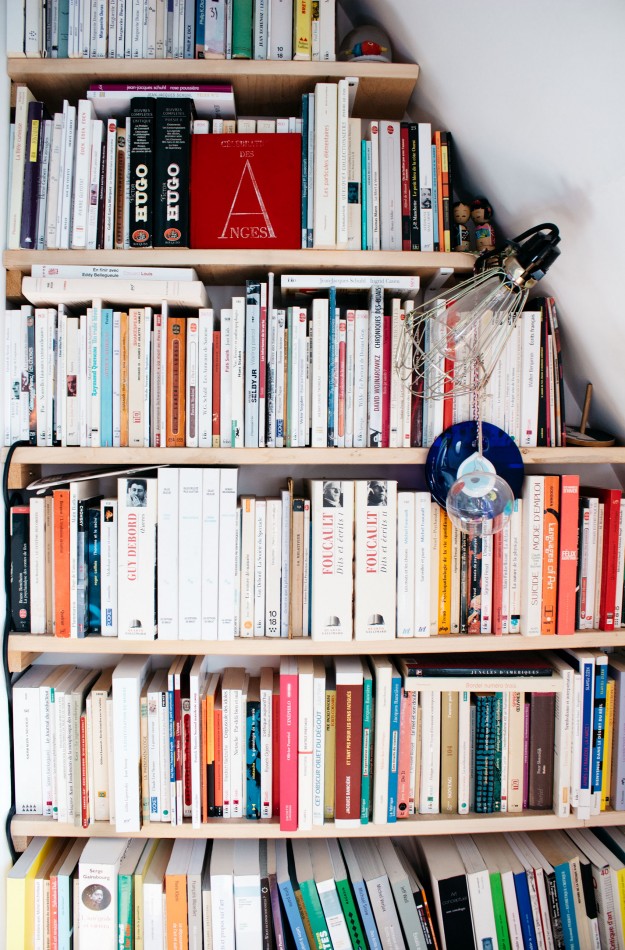



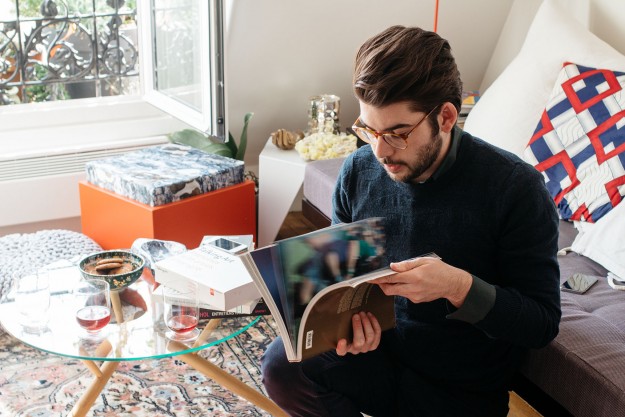

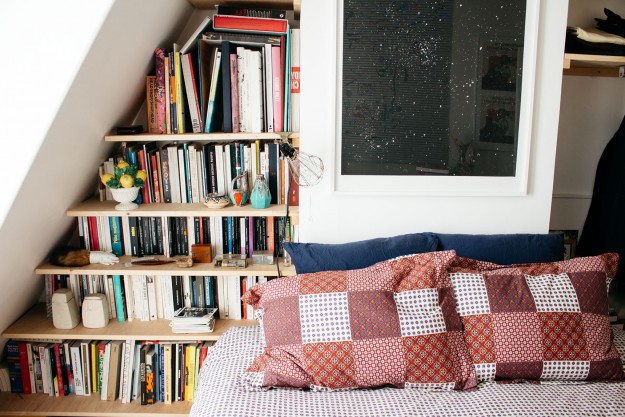

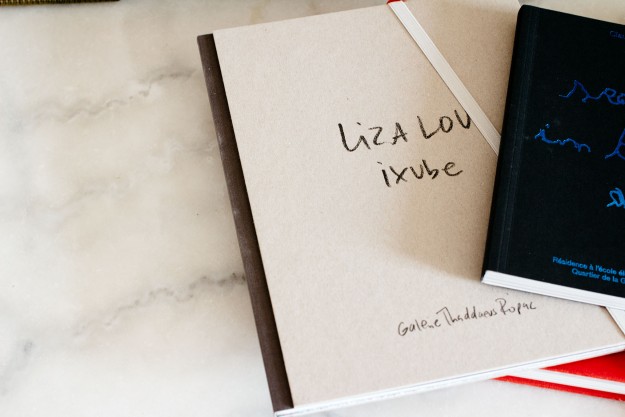
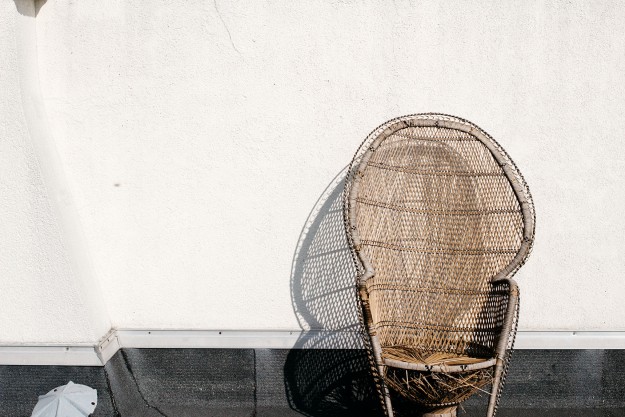
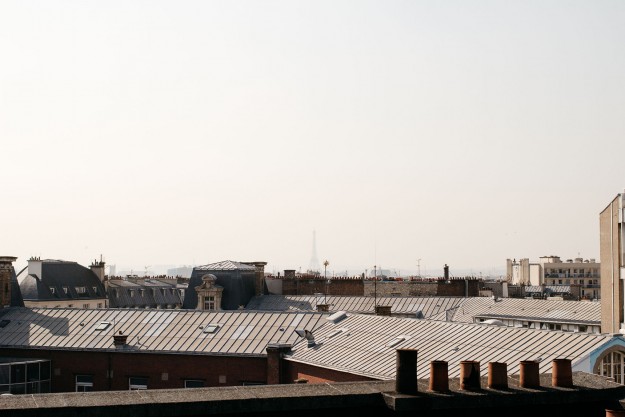
La bibliothèque – Timothée nous avait mis en garde : « Je vous reçois avec grand plaisir mais seulement 25 % de mes livres sont dans mon appartement parisien. Il m’en manque plus de 2000 qui sont éparpillés à l’extérieur». Après une rapide équation de notre part, le rendez-vous fut pris. En arrivant, on ne le regrette pas : des livres il y en a. En quantité et bien ordonné. Dans le salon : la littérature, les ouvrages philosophiques et poétiques. Dans la chambre : les ouvrages théoriques sur l’art, le cinéma, les monographies d’artistes contemporains et expositions collectives – chaque catégorie est rangée par ordre alphabétique. Timothée est commissaire d’exposition et ici il ne peut pas le cacher : l’art est partout. Dans les livres, mais aussi à travers les nombreuses œuvres d’artistes que l’on trouve au fil de la visite. On passe autant de temps à regarder les tableaux, dessins, photos que les livres. L’ensemble est savamment organisé, il y a beaucoup de choses à voir, mais rien ne semble de trop. Une prouesse que l’on doit sans doute au métier de Timothée. On a la déformation professionnelle qu’on mérite.
Bon, et alors, où se trouvent les livres qu’on ne peut pas voir ici ? « Ils sont éparpillés entre chez mes parents dans le Sud, chez ma marraine en Normandie et à New York. » Timothée y a habité quelques années. Un regroupement est-il envisagé ? « Vous savez quand on est passionné de livres, la question de l’encombrement se pose… je n’ai pas la place de tout avoir ici. » Et Timothée ajoute que les livres peuvent étouffer : « ils sont gorgés d’histoires après tout ».
Enfance et lectures – « Commençons par le début » propose Timothée qui aime donc l’ordre et la chronologie. Son premier souvenir est lié à un « livre-doudou en tissu » fabriqué par sa grand-mère. Il peut encore sentir la douceur de l’objet en fermant les yeux. Malheureusement, le livre est passé par la fenêtre d’une voiture lorsqu’il avait 5 ans. Premier déchirement – mais il s’en est remis. Deuxième souvenir, encore l’enfance : dans son parc à jouets, il feuilletait des catalogues de papier peint. Il sent encore sous ses doigts les différentes matières des papiers. Souvenir tactile. Pour lui les les livres sont liés aux sens. Autre souvenir : une collection de revue sur les grands musées du monde. Timothée avait une attirance particulière pour les images religieuses, les scènes de crucifixion et d’annonciation. Ses lectures d’enfant laissaient la nurse perplexe. C’était la naissance d’une vocation. Mais l’art fut une passion tardive. Avant de suivre cette voie, Timothée a emprunté plusieurs chemins, toujours plus ou moins liés à ses lectures. Il lit des livres sur l’Égypte, se passionne et veut être archéologue. Après un stage, il abandonne. « Quel ennui ! » Il dévore les livres de Patricia Cornwell, c’est décidé, il sera médecin légiste. Là encore, il trouve un stage : « Mais à la première goutte de sang, j’ai vu tout noir puis tout blanc. » Il abandonne. Comme quoi, la vie n’est pas toujours comme dans les livres. Ils ont pourtant été pour Timothée une façon d’apprendre, de comprendre le monde de façon autonome. « Mais le livre peut aussi te placer à côté de notre époque, te faire sortir de la norme, surtout à l’adolescence quand tu es le seul à lire ! »
En ce moment, Timothée préfère les formes courtes de narration, comme la poésie et les nouvelles. Celles de Jean-Jacques Schuhl par exemple. Sur sa table de chevet, on trouve : un recueil d’Aragon, les Dialogues de Duras et Godard et un essai Philosopher ou faire l’amour de Ruwen Ogien. « J’aime aussi les écrits d’artistes, les livres d’entretiens et les catalogues d’exposition. » précise Timothée. « Si tu n’as pas la possibilité d’avoir une œuvre d’un artiste, tu peux au moins avoir ses images…»
Papier et trappiste – Le grand-père de Timothée était moine trappiste et avait la charge de la bibliothèque. Sa maison était envahie de livres qu’il aimait partager avec tout le monde. La bibliothèque comme lieu de savoir et de transmission. Le penchant pour le papier, le goût des livres, c’est donc une histoire de famille pour Timothée qui reconnaît avoir été « bordé » de livres. L’imprimé devient un objet de culte. « L’une de mes grandes craintes : que ma bibliothèque brûle ! » On le comprend !
QUELQUES LIVRES À EMPRUNTER À TIMOTHÉE :
Obsessions de Jean-Jacques Schuhl, Gallimard, 2014 : onze nouvelles oniriques que Timothée affectionne particulièrement.
Des souris et des hommes de John Steinbeck, Gallimard, 1939 : le roman le plus connu de l’auteur se déroule aux Etats-Unis pendant la crise des années 30. Deux hommes rêvent d’avoir un petit lopin de terre. C’est le seul roman pour lequel Timothée a pleuré.
Salopes de Denis Cooper, POL, 2007 : Un roman choquant, d’une rare violence mais évidemment marquant. C’est la recherche d’un escort boy disparu, et l’évocation de son itinéraire, qui fournit la trame de ce roman que le brouillage des identités et la déréalisation introduite par l’utilisation du cyberspace portent à un point d’intensité où recherche esthétique et fantasme se conjuguent.
Andy Warhol. Entretiens 1962-1987 de Kenneth Goldsmith, Grasset, 2006 : Kenneth Goldsmith a choisi 37 entretiens de Andy Warhol sur la centaine que l’on peut aujourd’hui inventorier dans les Archives du Musée Andy Warhol de Pittsburgh. Certains sont inédits, d’autres publiés dans des revues aujourd’hui introuvables. Ils couvrent une grande variété de sujets : la peinture, le cinéma, la télévision, l’argent, la photographie, la mode, le sexe, la célébrité, la mort… Ce sont des textes, étranges, drôles, incisifs, qui dévoilent une personnalité en perpétuelle évolution. La mosaïque qu’ils composent offre un témoignage exemplaire sur l’une des périodes les plus fécondes de la culture américaine.
The Universal Addressability of Dumb Things, Marck Leckey, Hayward Publishing : le beau catalogue d’une exposition sur le « techno-animisme » où des objets inanimés prennent vie grâce à la technologie. Leckey juxtapose art contemporain, technologie, objets archéologiques et documents archéologiques.
SES BONNES ADRESSES :
Pour lire dans des décors de rêve : le parc public du Palazzo Savorgnan à Venise et la plage Espadilla Sur du Parc National Manuel Antonio au Costa Rica.
Le cinéma Utopia à Avignon.
Le café Rose Bakery dans le Marais à Paris (30 Rue Debelleyme, 75003 Paris) et Bakeri de Williamsburg à Brooklyn (150 Wythe Avenue, Brooklyn, NY 11211).
Bookcase
Timothée had told us: “I would be very happy to welcome you but I have only 25% of my books in my Parisian apartment. I have more than 2.000 other books that are dispersed in different places.” After a quick mental equation, the appointment is taken. And when we arrive, we don’t regret it at all: there are books. A lot of them. In the living room: literature, philosophy and poetry. In the bedroom: books about art, cinema and monographs about contemporary artists and art exhibitions – each category is classified by alphabetical order. Timothée works as a curator and he cannot hide it: art is everywhere at his place. In the books but also in the numerous art works that are everywhere. We spend as much time looking at the paintings, drawings and photographs as looking at the books. The whole is skilfully combined. There are lots of things to see but it is never too much. We can guess the curator’s talent.
And so, where are the missing books? “They are dispersed between my parents’ place in the South of France, my godmother’s in Normandy and also in New York” where Timothée has lived a few years. Is he thinking about eventually grouping them together? “You know, when you love books, space is a bit of a problem… I can’t have them all here. And Timothée adds that books can be suffocating: “they contain stories after all”.
Childhood and readings
“Let’s start from the beginning” suggests Timothée who likes order and chronology. His first memory is linked to a textile book made for him by his grandmother. He can remember its softness under his fingers if he closes his eyes. Unfortunately the books fell from the window when he was 5. First heartache – but he got over it. Second memory from childhood: in his playpen, he loved too play with catalogues of tapestries. He liked the colours and the materials. We understand that books are something very sensorial for Timothée. Other memory: a book about great museums. With a particular taste for scenes of crucifixion and annunciation. His nurse never really got to understand his childhood readings. But it was the vocation. But art was a late passion. Before following this path, Timothée tried other ways, always more or less linked with is readings: he reads about Egypt and wants to become archaeologist. After an internship he changes his mind: “So boring!” He reads all the thrillers by Patricia Cornwell and he makes a decision, he will be a coroner. Here again, an internship: “but at the first drop of blood I saw dark spots and then all white”. He gives up. Indeed life is not always like in the books but they definitively have been for him a great way to learn the world. “But books can also make you feel very special and kind of old-fashioned, especially as a teenager when you are the only one to read!”
At the moment, Timothée prefers short texts such as poetry and short stories collections. “I also like writings by artists, interviews of artists and exhibition catalogues” he says. “When you can’t afford the work of an artist, you can at least have pictures of the work…”
Paper and Trappist
Timothée’s grandfather was a Trappist monk and was in charge of the monastery’s bookcase. His house was invaded with books that he loved to share with everyone. The bookcase as the place of knowledge and tradition. The taste for paper and books is therefore a family story recognises Timothée. “One of my greatest fears: that my bookcase would burn!” How we understand him!
A FEW BOOKS TO BORROW FROM TIMOTHÉE:
Of Mice and Men by John Steinbeck, Covici Friede : Published in 1937, it tells the story of George Milton and Lennie Small, two displaced migrant ranch workers, who move from place to place in search of new job opportunities during the Great Depression in California.
I’ll Be Your Mirror: The Selected Andy Warhol Interviews Entretiens by Kenneth Goldsmith, Da Capo Press: Writer and radio host Goldsmith presents the first collection of Warhol interviews, some never before published and all hilarious, arch, and indicative of Warhol’s peculiarly prescient and pervasive genius. Over the course of three decades, Warhol toyed with his interlocutors, vamping and evading, and concealing shrewd social and aesthetic insights within seemingly insipid remarks. Warhol was, indeed, a mirror, a spinning disco ball reflecting the superficiality and pathos of human existence, and Goldsmith’s meticulous and arresting collection, brilliantly introduced by Reva Wolf, is a key addition to the Warhol canon.
The Universal Addressability of Dumb Things, Marck Leckey, Haylawrd Publishing: Curated by Turner Prize-winning artist Mark Leckey this exibithion explores the theme of “techno-animism,” whereby the inanimate comes to life through technology. Leckey juxtaposes contemporary art with machines, archeological objects and historical documents.
